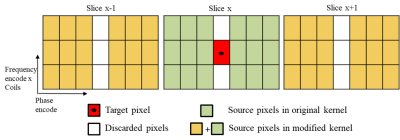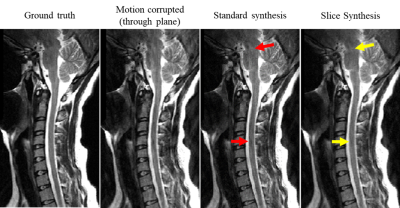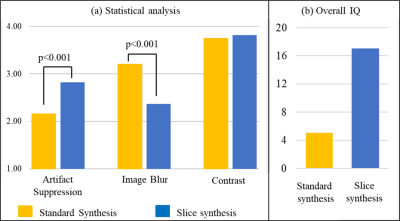4995
COCOA Synthesis Using Adjacent Slices for Improved Motion Artifact Correction1Canon Medical Research USA, Mayfield Village, OH, United States
Synopsis
A modified COCOA framework was introduced to suppress motion artifacts. The data convolution operation in COCOA was extended to include k-space neighbors in the slice dimension along with those in the slice. Regularization in the data convolution operation was used as an alternative to the data combination in COCOA. The proposed technique provided high motion artifact suppression as compared to the standard COCOA synthesis.
Introduction
MRI is a slow imaging modality, which makes it susceptible to patient motion. The motion artifacts adversely affect the image quality rendering them non-diagnostic. Many different techniques have been proposed to correct motion artifacts in a retrospective1-4 or prospective manner5. One such technique called data convolution and data combination operation (COCOA)1 was developed to correct sporadic non-rigid motion. The data convolution operation disperses motion-related k-space errors at any given location to its neighbors within the slice. Since different k-space locations correspond to different motion states, the reduction of motion-related errors at each location reduces overall motion artifact. However, the effectiveness of this technique is reduced as motion artifacts increase. In this work, we modified the convolution operation to include k-space neighbors in the slice dimension along with those within the slice. We evaluated the performance of our proposed technique in sagittal T2w C-spine MRI.Methods
The data convolution operation in COCOA approximates the k-space signal at a location by a linear combination of k-space signals from its neighbors within the slice. A new k-space is synthesized from the motion-corrupted k-space using convolution kernels. The calibration region, consisting of a few central PE lines from the motion-corrupted k-space, is used in estimating the kernel weight. The convolution kernel for the target pixel (shown in red) in slice x is shown in Figure 1. The kernel used in the standard synthesis contains neighboring pixels from slice x (shown in green). We propose a modified kernel that contains neighboring pixels from within the slice (shown in green) and those from adjacent slices (shown in yellow). As an alternative to the data combination step of COCOA, L2 regularization is used in the kernel weight estimation to reduce noise amplification and maintain SNR. The COCOA synthesis with the modified kernel is referred to as slice synthesis. Simulation Study: To test the proposed method, a sagittal 2D FSE C-spine dataset was collected on a volunteer using a Vantage Galan 3T MR (Canon Medical Systems Corporation, Tochigi, Japan) and 16-ch Atlas SPEEDER Head/Neck coil under institutional IRB-approved protocol. The volunteer was instructed to remain still during the scan. Sequence parameters were as follows: spatial resolution=0.76mm2, slice thickness=3mm, slice-gap=0.6mm, echo train length=17, number of shots=31, slices=13. In the first simulation, in-plane rigid-body translation motion was simulated for 6 of 31 shots. In the second simulation, a through-plane translational motion was added to 6 of 31 shots. The motion parameters for both simulations were between [-5mm, +5mm]. The simulated data were then processed with both original COCOA synthesis and modified COCOA slice synthesis. In-Vivo Study: 3 volunteers were scanned for in-vivo performance evaluations using the same MR system and pulse sequence parameters as implemented in the simulation study. Each volunteer was asked to perform different motion maneuvers (n=6) with different event frequencies (n=3), for a total of 54 scans. Rigid motion correction was first applied to these datasets to enhance the image quality for a better visual comparison of COCOA synthesis. Out of 54 total datasets, 22 datasets with perceivable motion were chosen for analysis. An applications specialist with 13 years of experience reviewed the images while blinded to the method applied to each image. The image quality of reconstructions (with standard and slice synthesis) was graded on a Likert scale 1-4 (1: Non-diagnostic, 2: Poor, 3: Diagnostic, 4: Good). Along with the overall IQ, grading was also done for 3 other categories: artifact suppression, image blur, and contrast. A Wilcoxon’s signed-rank test was conducted for statistical comparisons in each category.Results
Figures 2 and 3 show the results for the simulated datasets. The reconstructions from slice synthesis yielded superior artifact reduction (yellow arrows) for both in-plane and through-plane motion simulations. Results for 4 of the 22 datasets are shown in Figure 4. The cord is more homogenous and exhibits fewer residual artifacts (yellow arrows) in the images reconstructed using the modified approach. However, a minor increase in image blur was noticed (blue arrows) with the modified approach. These visual findings were confirmed with the reader analysis as seen from Figure 5(a). Slice synthesis showed a statistically significant improvement in artifact suppression with a consistent increase in image blur. The contrast did not change with either approach. For 17 out of 22 datasets, images reconstructed with the slice synthesis approach were chosen as having superior overall IQ as seen in Figure 5(b).Discussion
COCOA synthesis with adjacent slices consistently provided better artifact suppression. This can be attributed to a higher dispersion of k-space error due to motion in the highly correlated k-space neighbors. Challenges related to this approach include noise amplification and increased image blur. The increase in image blur can be attributed to the L2 regularization used to minimize noise amplification. One of the requirements of the approach is that the adjacent slices have high k-space correlations. This can hinder its application in acquisitions with slice interleaving, and a large slice gap. Further investigation on alternative approaches to minimize image blur and maintain SNR is necessary.Conclusion
The preliminary study shows that extending COCOA synthesis to include neighbors in the slice dimension yields superior artifact suppression for data exposed to sporadic motion.Acknowledgements
No acknowledgement found.References
1. Huang, F., Lin, W., Börnert, P., Li, Y. and Reykowski, A., 2010. Data convolution and combination operation (COCOA) for motion ghost artifacts reduction. Magnetic resonance in medicine, 64(1), pp.157-166.
2. Pipe JG. Motion correction with PROPELLER MRI: application to head motion and free‐breathing cardiac imaging. Magnetic Resonance in Medicine: An Official Journal of the International Society for Magnetic Resonance in Medicine. 1999 Nov;42(5):963-9.
3. Lin, W., Huang, F., Börnert, P., Li, Y. and Reykowski, A., 2010. Motion correction using an enhanced floating navigator and GRAPPA operations. Magnetic Resonance in Medicine: An Official Journal of the International Society for Magnetic Resonance in Medicine, 63(2), pp.339-348
4. Cordero-Grande, L., Teixeira, R.P.A., Hughes, E.J., Hutter, J., Price, A.N. and Hajnal, J.V., 2016. Sensitivity encoding for aligned multishot magnetic resonance reconstruction. IEEE Transactions on Computational Imaging, 2(3), pp.266-280.
5. Lange T, Taghizadeh E, Knowles BR, Südkamp NP, Zaitsev M, Meine H, Izadpanah K. Quantification of patellofemoral cartilage deformation and contact area changes in response to static loading via high‐resolution MRI with prospective motion correction. Journal of Magnetic Resonance Imaging. 2019 Nov;50(5):1561-70.
Figures




